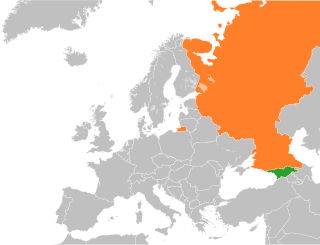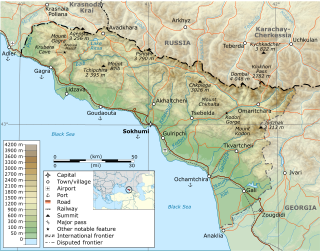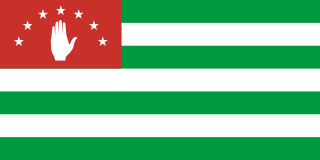The Kodori Valley, also known as the Kodori Gorge, is a river valley in Abkhazia, Georgia's breakaway autonomous republic. The valley's upper part, populated by Svans, was the only corner of the post-1993 Abkhazia directly controlled by the central Georgian government, which since 2006 officially styles the area as Upper Abkhazia. On August 12, 2008, Russo–Abkhazian forces gained control of the Upper Kodori Valley, previously controlled by Georgia.

The Abkhazia conflict is a territorial dispute over Abkhazia, a region on the eastern coast of the Black Sea in the South Caucasus, at the intersection of Eastern Europe and Western Asia. The conflict involves Georgia, Russian Federation and Russian-backed self-proclaimed Republic of Abkhazia, internationally recognised only by Russia, Venezuela, Nicaragua, Nauru, and Syria; Georgia and all other United Nations members consider Abkhazia a sovereign territory of Georgia. However, as of 2023, Georgia lacks de facto control over the territory.
Abkhazia is a region in the Caucasus that is under the effective control of the partially recognised self-declared Republic of Abkhazia. The de jure majority internationally recognized Autonomous Republic of Abkhazia claims to be its legitimate government.
The 2006 Kodori crisis erupted in late July 2006 in Abkhazia's Kodori Gorge, when a local militia leader declared his opposition to the Government of Georgia, which sent police forces to disarm the rebels. The upper part of the Kodori Gorge was at that time the only portion of Abkhazia, Georgia's breakaway republic, not controlled by the Abkhaz authorities.

Russia and Georgia have had relations for centuries. The contacts between the two date back to the 15th and 16th centuries, and the most important stage started in the 1580s, when the Georgian kingdom of Kakheti and the Russian Empire signed a treaty of alliance in 1587. Since then, Georgia–Russia relations have been developing vibrantly and culminated in the Treaty of Georgievsk, which established eastern Georgia as a protectorate of Russia. At that time, Georgia saw Russia as a powerful Christian and modernizing neighbor, capable of protecting Georgia from invading Muslim empires and North Caucasian raiders.

The history of Abkhazia, a region in the South Caucasus, spans more than 5,000 years from its settlement by the lower-paleolithic hunter-gatherers to its present status as a partially recognized state.

The Armenian Air Force is the air arm of the Armed Forces of Armenia formed by independent Armenia in 1992 in the wake of the dissolution of the Soviet Union. Outside its conventional name, it has also been referred to as the Aviation Department of the Armenian Armed Forces. It is organized and equipped principally to provide Armenian ground forces with tactical air support in the form of ground attack and airlift in mountainous terrain. It provided effective support during the battles with Azerbaijan in the Nagorno-Karabakh region from 1992 to 1994.
The Bagramyan Battalion, also known officially as the Independent Motorized Rifle Battalion named after Marshal Ivan Khristoforovich Baghramyan was a unit formed in Abkhazia and predominantly composed of ethnic Armenians living in Abkhazia that fought together with Russia backed separatist Abkhaz forces during the War in Abkhazia (1992–93). Named in honour of the Soviet Armenian Marshal Ivan Bagramyan, the battalion fought against the forces of Georgia. It was subsequently disbanded. It is considered a terrorist organisation by many international research organizations and Georgia.

The 4th Guards Air and Air Defence Forces Army is an air army of the Russian Aerospace Forces, part of the Southern Military District and headquartered in Rostov-on-Don.

The War in Abkhazia was fought between Georgian government forces for the most part and Abkhaz separatist forces, Russian government armed forces and North Caucasian militants between 1992 and 1993. Ethnic Georgians who lived in Abkhazia fought largely on the side of Georgian government forces. Ethnic Armenians and Russians within Abkhazia's population largely supported the Abkhazians and many fought on their side. The separatists received support from thousands of North Caucasus and Cossack militants and from the Russian Federation forces stationed in and near Abkhazia.
The Battle of Gagra was fought between Georgian forces and the Abkhaz secessionists aided by the Confederation of Mountain Peoples of the Caucasus (CMPC) militants from 1 to 6 October 1992, during the War in Abkhazia. The allies, commanded by the Chechen warlord Shamil Basayev, captured the town of Gagra from the undermanned Georgian forces in a surprise attack, leading to an outbreak of ethnic cleansing of local Georgian population. The battle proved to be one of the bloodiest in the war and is widely considered to be a turning point in the Georgian-Abkhaz conflict. The action, in which Russian commanders were suspected to have aided to the attackers, also resulted in a significant deterioration of the Georgian-Russian relations.

The Abkhazian Armed Forces are the military forces of Abkhazia. The forces were officially created on 12 October 1992, after the outbreak of the 1992–1993 war with Georgia. The basis of the armed forces was formed by the ethnic Abkhaz National Guard. The Abkhaz military is primarily a ground force but includes small sea and air units. According to the authorities of the Republic of Abkhazia, the Abkhazian Land Forces are organised along the Swiss model – in time of peace they have personnel of 3,000 to 5,000 and in case of war further 40–50,000 reservists are called out. Georgia regards the Abkhaz armed forces as "unlawful military formations" and accuses Russia of supplying and training the Abkhaz troops.

The 2007 Georgia helicopter incident refers to the accusation by Georgia that three Russian helicopters fired on the Kodori Gorge in Abkhazia on March 11, 2007. It was a break-away autonomous republic in north-western Georgia The attack was at the village of Chkhalta, which damaged a school, and the government headquarters of the Georgian-backed Abkhaz government-in-exile. Russia denied any attacks and said all its aircraft near the area were grounded over the weekend.
The 2007 Bokhundjara incident refers to a skirmish that occurred between Georgia and its breakaway republic of Abkhazia near the border with Georgia proper in Abkhazia Tkvarcheli District on September 20, 2007, between Georgian Interior Ministry commandos and Abkhaz forces. The United Nations Observer Mission in Georgia (UNOMIG) launched an independent investigation of the incident. On October 11, 2007, it released a progress report, confirming the incident took place on Abkhaz-controlled territory at the foot of Mount Bokhundjara, thus confirming the Abkhaz version of the event. On October 27, 2007, Georgia released the arrested Abkhazians and handed them over to the U.N. observers as a "sign of good will."

The Abkhazian town of Tkvarcheli was put under siege by the Georgian National Guard during the 1992–93 War in Abkhazia. The siege lasted from October 1992 to September 1993, almost the entire duration of the war, but was eventually unsuccessful. It was accompanied by inconclusive fighting in surrounding villages. Russian aid, both humanitarian and military, was critical for the defence of the town which suffered a severe humanitarian crisis during the siege.
2008 Georgian drone shootdowns refers to several incidents in March, April and May 2008, when Georgia's pro-Russian breakaway region of Abkhazia claimed to have shot down unmanned Georgian reconnaissance aircraft. Georgia initially denied that any of these downings took place, but made the allegations public following the April 20 shootdown carried out by a fighter jet belonging to the Russian Air Force. Involvement of the Russian military was denied by the Abkhaz separatists and Russia, with both falsely claiming that the separatists alone had accomplished the task. However, Russian military involvement was later confirmed by a UNOMIG fact finding mission which represented its results on May 26. On June 1, in a note sent to the Russian delegation at the Organization for Security and Co-operation in Europe (OSCE), Georgia recognised that two other downings of its drones had taken place in the past.

The Battle of the Kodori Valley was a military operation during the Russo-Georgian War in the Upper Kodori Valley of Abkhazia, a breakaway region of Georgia. It was the only part of Abkhazia under Georgian control before this military conflict. On 9 August 2008, the Abkhaz military, with support by Russian forces, launched an operation to remove the remaining Georgian troops from the disputed gorge. After three days, the Georgian military left the Upper Kodori Valley.

Abkhazia, officially the Republic of Abkhazia, is a partially recognised state in the South Caucasus, on the eastern coast of the Black Sea, at the intersection of Eastern Europe and Western Asia. It covers 8,665 square kilometres (3,346 sq mi) and has a population of around 245,000. Its capital and largest city is Sukhumi.
The War in Abkhazia from 1992 to 1993 was waged chiefly between Georgian government forces on one side, Russian military forces on other side supporting separatist forces demanding independence of Abkhazia from Georgia. http://www.historyorb.com/russia/georgia.php Ethnic Georgians, who lived in Abkhazia fought largely on the side of Georgian government forces. Ethnic Armenians and Russians within Abkhazia's population, largely supported Abkhazians and many fought on their side. The separatists were supported by thousands of the North Caucasus and Cossack militants and by the Russian Federation forces stationed in and near Abkhazia.
The Battle of Gumista was a battle between Georgian armed forces and Abkhaz separatists. It was the bloodiest clash of the Abkhaz–Georgian conflict and the War in Abkhazia. It was held on March 15–16, 1993 along 8 kilometres (5.0 mi) of the banks of the Gumista River.












